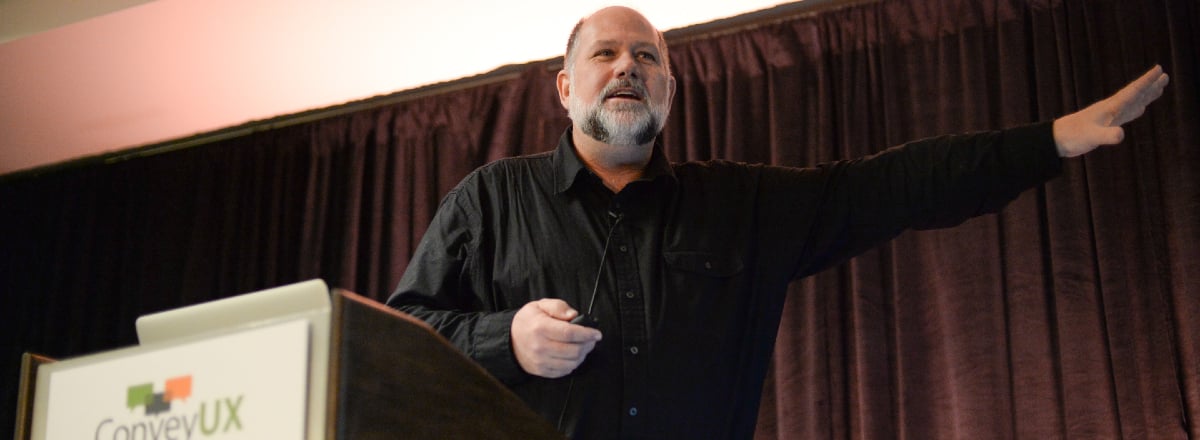
Above: Alan Baumgarten speaking at Convey UX.
For anyone who regularly designs enterprise software (raising my hand here), you have likely been asked to move a dated, difficult-to-use interface to a modern user experience. Below we have Exhibit A – rather extreme – but nevertheless an example of the type of interface that is still in use in some enterprise contexts:
It’s easy to ridicule a UI such as this, and clients are sometimes apologetic in showing us their legacy systems, but it’s important to remember that these systems have often served the company well for many years, are highly embedded in business processes, and re-architecting them is a major, potentially disruptive, endeavor.
A term that often pops up in these re-architecture projects is “consumer-grade UX.” I was very glad, therefore, to hear Alan Baumgarten address the idea of applying consumer-grade UX to enterprise systems in his recent talk at ConveyUX. Consumer-grade UX for the enterprise sounds like a good idea and a number of enterprise system vendors promote their experience as “consumer-grade.” However, the context of use for enterprise systems is generally very different than for consumer applications and web sites—a factor that doesn’t always get the attention it should.
In his talk, Alan began by outlining the typical differences between consumer and enterprise users. To illustrate his point, he showed two photos of a Toyota Camry interior: the interior for consumers and the interior for a NASCAR driver.
Clearly the NASCAR interior is designed for a very specific (and expert) context of use. You would never design a consumer interior like this, but the design is perfectly suited to the professional racecar driver.
So even when faced with an interface as seemingly terrifying as my Exhibit A, it’s important not to dismiss the approach out-of-hand. There could be elements that meet user needs appropriately.
So what principles of consumer UX do apply to the enterprise?
I like Alan’s premise:
“Consumer-grade is not consumer-like. Professionals differ from consumers in significant ways; nevertheless, everyone deserves to have a positive experience. Delight is universal.”
He continues with some specific design attributes:
- Consumer-grade is contemporary. The user interface looks new, modern, and elegant. Styles are regularly updated to keep the design fresh.
- Consumer-grade implies desirability. Professionals often don’t have a choice in the technology they use, but the quality of the experience should assume that they do.
- Consumer-grade is intuitive. Even highly trained professionals should immediately feel comfortable seeing enterprise solutions for the first time; they recognize elements that align with their job. Task flows are sensible and obvious.
For commercial providers of enterprise software, providing a consumer-grade experience has become an imperative in the marketplace. We’ve seen established players start to lose market share against newer, less-feature-rich solutions that nonetheless provide a more compelling user experience.
For internal systems, a whole generation that grew up on compelling consumer experiences is bringing those expectations into the workplace. The type of interfaces typical of legacy systems is literally something they’ve never seen before. It impacts both productivity and workplace satisfaction.
The other factor is mobile. People don’t expect their experiences to be chained to the desktop—they expect to be able to work on a range of devices. Not all enterprise solutions make sense for mobile, but many do.
And finally, another issue for enterprise UX is that companies often build their offerings through acquisitions. Products purchased from different companies are cobbled together into a single solution resulting in a fragmented, inconsistent user experience.
These are all challenges we are very much feeling in our design practice at Blink as we engage with companies to upgrade their enterprise UX. Our clients have found that our user-centered approach helps mitigate the risks associated with a big UX transition. The key is to focus on the specialized needs of the enterprise user—not to simply copy design patterns over from the world of consumer UX. However, that still provides plenty of room to provide a desirable, intuitive experience for users with highly specialized needs.
Heidi works in Interaction Design and is a Partner at Blink. She divides her leisure time between classical music, cooking, and the Seattle Mariners.
